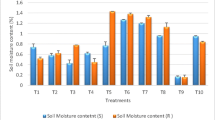Abstract
Aseptic tomato and radish roots were found to exude, respectively, 2.8–5.3 and 290–390 ng tryptophan per seedling per day. The inoculation of radish plants with rhizosphere pseudomonads increased the root biomass by 1.4 times. The inoculation of tomato plants with the same pseudomonads was ineffective. The beneficial effect of bacterial inoculation on the radish plants can be explained by the fact that the introduced rhizobacteria produce the plant growth–stimulating hormone indole-3-acetic acid. In pot experiments, the addition of this phytohormone to the soil increased the mass of radish roots by 36%. The phytohormonal action of the rhizosphere microflora was found to be efficient provided that the concentration of tryptophan in the rhizosphere is sufficiently high.
Similar content being viewed by others
REFERENCES
Frankenberger, W.T. and Arshad, M., Phytohormones in Soil: Microbial Production and Function, New York: Marcel Dekker, 1995.
Gamburg, K.Z., Biokhimiya auksina i ego deistvie na kletki rastenii (Biochemistry of Auxin and Its Action on Plant Cells), Novosibirsk: Nauka, 1976.
Fallik, E., Sarig, S., and Okon, Y., Morphology and Physiology of Plant Roots Associated with Azospirillum, Okon, Y., Ed., London: CRC, 1994, pp. 77–86.
Sarwar, M., Arshad, M., Martens, A., and Frankenberger, W.T., Tryptophan-Depended Biosynthesis of Auxin in Soil, Plant Soil, 1992, vol. 147, pp. 207–215.
Kravchenko, L.V. and Leonova, E.I., The Use of the Root Exometabolite Tryptophan by Plant-associated Bacteria for the Biosynthesis of Indole-3-Acetic Acid, Mikrobiologiya, 1993, vol. 62,no. 3, pp. 453–459.
Kravchenko, L.V., Makarova, N.M., Azarova, T.S., Provorov, N.A., and Tikhonovich, I.A., Isolation and Phenotypic Characterization of Plant Growth-promoting Rhizobacteria with High Antiphytopathogenic Activity and Root-colonizing Ability, Mikrobiologiya, 2002, vol. 71,no. 4, pp. 521–525.
Simons, M., van der Bij, A.J., Brand, J., et al., Gnotobiotic System for Studying Rhizosphere Colonization by Plant Growth-Promoting Pseudomonas Bacteria, Mol. Plant-Microbe Interact., 1996, vol. 9, pp. 600–607.
Sambrook, J., Fritsch, E.F., and Maniatis, T., Molecular Cloning: A Laboratory Manual, 2nd ed., Cold Spring Harbor: Cold Spring Harbor Lab., 1989.
Leeman, M., van Pelt, J.A., Hendrickx, M.J., Sheffer, R.J., Bakker, P.A.H.M., and Shippers, B., Biocontrol of Fusarium Wilt of Radish in Commercial Greenhouse Trials by Seed Treatment with Pseudomonas fluorescens WCS374, Phytopathology, 1995, vol. 85, pp. 1301–1305.
Author information
Authors and Affiliations
Rights and permissions
About this article
Cite this article
Kravchenko, L.V., Azarova, T.S., Makarova, N.M. et al. The Effect of Tryptophan Present in Plant Root Exudates on the Phytostimulating Activity of Rhizobacteria. Microbiology 73, 156–158 (2004). https://doi.org/10.1023/B:MICI.0000023982.76684.9d
Issue Date:
DOI: https://doi.org/10.1023/B:MICI.0000023982.76684.9d




